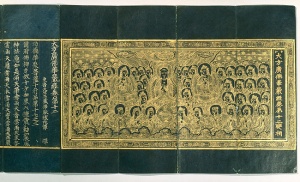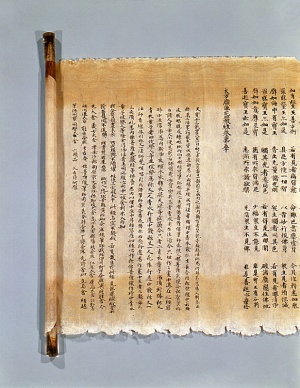Huayan school
The Huayan school (Chinese: 華嚴宗; pinyin: Huáyán Zōng; Japanese: Kegon; Korean: 화엄종 (Hwaeom jong); Sanskrit: Avataṃsaka) or Flower Garland is a tradition of Mahayana Buddhist Philosophy that flourished in China during the Tang period.
It is based on the Sanskrit Flower Garland Sutra (S. Avataṃsaka Sūtra, C. Huayan Jing) and on a lengthy Chinese interpretation of it, the Huayan Lun. The name Flower Garland is meant to suggest the crowning glory of profound understanding.
Origins and development
Origins
The Hua-yen school was established during the period of the end of the Sui and beginning of Tang Dynasty (c. 600-700 C.E.). The Tiantai-school, which was favored by the Sui Dynasty, fell in digrace.
The Tang rulers favored Taoism, but under Emperor Taizong (627–650) Interest in Buddhism, especially Yogacara, relived at the court. Empress Wu Zetian (684–705) supported the Hua-yen school of Fazang.
Patriarchs
The founding of the school is traditionally attributed to a series of five "patriarchs" who were instrumental in developing the schools' doctrines. These five are (Wade-Giles in brackets):
- Dushun (Tu-Shun), 杜順, responsible for the establishment of Huayan studies as a distinct field;
- Zhiyan (Chih-yen), 智儼, considered to have established the basic doctrines of the sect;
- Fazang (Fa-tsang), 法藏, considered to have rationalized the Doctrine for greater acceptance by society;
- Chengguan (Ch'eng-kuan), 澄觀, together with Zongmi are understood to have further developed and transformed the teachings
- Zongmi (Tsung-mi), 宗密, who is simultaneous a Patriarch of the Chan tradition.
These men each played a significant and distinct role in the development of the school, although there are certain aspects of this patriarchal scheme which are clearly contrived.
For example, Chengguan was born 26 years after Fazang's Death. Another important figure in the development and popularization of Huayan Thought was the lay scholar Li Tongxuan (李通玄).
Some accounts of the school also like to extend its patriarch-ship earlier to Aśvaghoṣa and Nāgārjuna.
Sagnation
After the time of Zongmi and Li Tongxuan the Chinese school of Huayan generally stagnated in terms of new development, and then eventually began to decline.
The school, which had been dependent upon the support it received from the government, suffered severely during the Buddhist purge of 841-845, initiated by Emperor Wuzong, never to recover its former strength.
Nonetheless, its profound metaphysics, such as that of the Four Dharmadhātu (四法界) of interpenetration, had a deep impact on surviving East Asian schools.
Texts
The Hua-yen school centered on the philosophy of interpenetration and mutual containment which its founders perceived in the Avatamsaka Sutra.
Avatamsaka Sutra
The Avatamsaka Sutra is a compilation of sutras of various length. The earliest of these texts, the Daśabhūmika Sūtra, maybe dates from the first century CE.
The Daśabhūmika Sūtra describes the ten stages on the Bodhisattva-path. The various sutras were probably joined together shortly before its translation into Chinese, at the beginning of the 5th century CE.
The Avatamsaka ("garland", string of Flowers) Sutra integrates the teachings on Sunyata and vijnaptimatra (Mind-only). The basic idea of the Avatamsaka Sutra is the unity of the absolute and the relative:
All in One, One in All. The All melts into a single whole.
There are no divisions in the totality of reality [...] [I]t views the cosmos as holy, as "one bright pearl," the universal reality of The Buddha. The universal Buddhahood of all reality is the religious message of the Avatamsaka-Sutra.
Each part of the World reflects the totality of the cosmos:
In each dust-mote of these worlds
Are countless worlds and Buddhas...
From the tip of each Hair of Buddha's Body
Are revealed the indescribable Pure Lands...
The indescribable infinite Lands
All levels of reality are related and interpenetrated. This is depicted in the image of Indra's net. This "unity in totality allows every individual entity of the phenomenal World its uniqueness without attributing an inherent nature to anything".
Commentaries
Yet despite basic reliance on this Sutra, much of the technical terminology that the school became famous for is not found in the Sutra itself, but in the commentaries written by its early founders. The most important of these commentaries is Tu-shun's Fa Chieh Kuan, "On the Meditation of the Dharmadhatu".
Awakening of Faith
Fa-zang also relied on the Awakening of Faith in the Mahayana, which was a condensation of Chinese Thought on Awakening and ultimate reality.
Philosophy
Interpenetration
The most important philosophical contributions of the Huayan school were in the area of its metaphysics. It taught the Doctrine of the mutual containment and interpenetration of all Phenomena, as expressed in Indra's net. One thing contains all other existing things, and all existing things contain that one thing.
Distinctive features of this approach to Buddhist Philosophy include:
- Truth (or reality) is understood as encompassing and interpenetrating falsehood (or Illusion), and vice versa
- Good is understood as encompassing and interpenetrating Evil
- Similarly, all Mind-made distinctions are understood as "collapsing" in the Enlightened understanding of Emptiness (a tradition traced back to the Buddhist Philosopher Nagarjuna)
Four Dharmadhatu
Huayan teaches the Four Dharmadhatu, four ways to view reality:
- All dharmas are seen as particular separate events;
- All events are an expression of the absolute;
- Events and essence interpenetrate;
- All events interpenetrate.
Paradox
Huayan makes extensive use of paradox in argument and literary imagery.
All three types of paradox originate in the tension between conventional Truth and absolute Truth. Huayan uses three types of paradox:
1.Emphasizing the concept of Sunyata, first is asserted that a Phenomenon X is empty, which implies that X is not X. An example from Fa-tsang is the assertion that
When one understands that origination is without self-nature, then there is no origination.
2. Reversing the first paradox by asserting that any empty Phenomenon is an expression of the absolute Non-duality between Emptiness and Form, or the identity between conditioned, relative reality and the ultimate Truth of suchness (chen-ju(j). This paradox is derived from two doctrinal sources:
- The Hua-yen concept of "true Emptiness" (chen-k'ung(g)), and
- The Hua-yen interpretation of the dialectic of the One Mind (i-hsin(h)) in the Awakening of Faith.
Fa-tsang's paradoxical assertion illustrates this second type:
When the great Wisdom of perfect clarity gazes upon a minute Hair,the universal sea of nature, the true source, is clearly manifest.
3. The third variation of paradox is grounded in the Hua-yen Doctrine of the "nonobstruction of all Phenomena" (shih shih wu-ai(k)). Each Phenomenon is perceived as interpenetrating with and containing all others.
This paradoxical violation of the conventional order of time and space is exemplified by Fa-tsang's famous "Essay on the Golden Lion":
In each and every Hair [of the lion) there is the golden lion. All of the lions contained in each and every Hair simultaneously and suddenly penetrate into one Hair. [Therefore], within each and every Hair there are unlimited lions.
Classification of Buddhist teachings
Buddhism was introduced into China in bits and pieces. When the Knowledge of Buddhism grew larger, various schools attempted to get a grip on the Buddhist tradition by developing classifications of teachings, such as the Five Periods and Eight Teachings of the Tiantai-school.
The Hua-yen school developed a fivefold classification:
- The Hinayana-teachings, especially the Sarvastivadins
- The Mahayana-teachings, including Yogacara, Madhyamaka
- The "Final Teachings", based on the Tathagatagarbha-teachings, especially the Awakening of Faith
- The Sudden Teaching, "which 'revealed' (hsien) rather than verbalised the teaching"
- The Complete, or Perfect, Teachings of the Avatamsaka-Sutra and the Hua-yen school.
Since Chán emphasised sudden Awakening, the teachings of the Chán-school were regarded as inferior to the Hua-yen teachings. The Chán-school polemitized against this classification, by devising its own rhetorics in defense.
Influence
The doctrines of the Huayan school ended up having profound impact on the philosophical attitudes of all of East Asian Buddhism. Chinese Chán was profoundly influenced by it, though Chán also defined itself by profilating itself from Huayan.
Tsung-mi, the Fifth Patriarch of the Hua-yen school, also occupies a prominent position in the history of Chán.
During the Song, the Hua-yen metaphysics were completely assimilated by the Chán-school.


